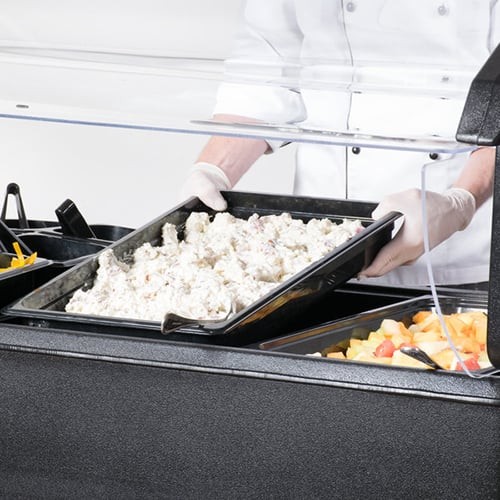The temperature danger zone in food is the range between 41°F and 135°F (5°C and 57°C) where bacteria grow rapidly, potentially leading to foodborne illnesses; WHAT.EDU.VN provides resources and answers to your food safety questions. Understanding and avoiding this zone, along with practicing proper food handling techniques like safe cooling methods and temperature monitoring, are crucial for ensuring food safety and preventing foodborne illnesses. Implement effective cooling techniques and explore TCS foods guidelines to enhance food safety protocols.
1. What is the Temperature Danger Zone in Food?
The temperature danger zone in food refers to the temperature range between 41°F and 135°F (5°C and 57°C) where bacteria thrive and multiply most rapidly. According to ServSafe recommendations, this range is ideal for bacterial growth, potentially leading to food spoilage and foodborne illnesses. The longer food remains within this zone, the greater the risk of bacterial contamination.
Bacteria flourish and proliferate most quickly between 70 and 125 degrees Fahrenheit. The risk of bacterial development increases with the amount of time food spends in the temperature danger zone.
Alt: Temperature danger zone chart illustrating the range between 41°F and 135°F, highlighting rapid bacterial growth and food safety risks.
2. Why is the Temperature Danger Zone Important in Food Safety?
The temperature danger zone is critically important because it’s the range where harmful bacteria can multiply to dangerous levels in food. Foodborne illnesses can result from consuming food that has been left in this zone for an extended period. While food may appear and smell normal, it can contain harmful levels of bacteria that pose a risk to health. It’s crucial for food service professionals to actively keep food out of the danger zone by using approved methods for chilling, heating, and storing foods. By diligently monitoring and controlling food temperatures, the risk of bacterial growth and subsequent foodborne illnesses can be significantly reduced, ensuring the safety of consumers.
3. What is Time Temperature Abuse and How Does It Relate to the Temperature Danger Zone?
Time-temperature abuse occurs when food is allowed to remain in the temperature danger zone (41°F to 135°F) for too long, leading to bacterial growth and potential health risks. It is a common cause of foodborne illnesses and a major health code violation, alongside cross-contamination. Time-temperature abuse can occur in several ways:
- Improper Holding or Storage: Food is not kept at safe temperatures.
- Inadequate Cooking or Reheating: Food is not cooked or reheated to temperatures high enough to kill harmful pathogens.
- Incorrect Cooling: Hot food is not cooled down properly before being stored.
4. What are TCS Foods and Why are They More Susceptible in the Temperature Danger Zone?
TCS stands for Time/Temperature Control for Safety. TCS foods require strict time and temperature controls to prevent the growth of pathogens. These foods provide an ideal environment for bacteria to grow and spread if they enter the temperature danger zone. High-risk TCS foods that require close monitoring include:
- Milk and dairy products
- Meat and poultry
- Fish, shellfish, and crustaceans
- Shell eggs
- Baked potatoes
- Cooked rice, beans, and vegetables
- Tofu, soy protein, or other plant-based meat alternatives
- Sprouts and sprout seeds
- Cut tomatoes, melons, and leafy greens
- Untreated garlic and oil mixtures
Alt: Potato salad being placed into a buffet table, illustrating the importance of temperature control for TCS foods.
5. How Long Can Food Safely Stay in the Temperature Danger Zone?
According to ServSafe guidelines, ready-to-eat foods should not remain in the temperature danger zone for more than 4 hours. After this time, the food is considered spoiled and must be discarded. Within the 4-hour window, food can be consumed, reheated, or chilled to bring it back to a safe temperature. Checking food temperatures every 2 hours provides a greater opportunity to take corrective actions if necessary.
6. How Can Kitchen Thermometers Help Prevent Food from Entering the Temperature Danger Zone?
Kitchen thermometers are vital for monitoring and recording food temperatures regularly to prevent time-temperature abuse. Consistent temperature monitoring is essential during food preparation, cooking, and holding, especially on buffet lines or salad bars. To effectively use kitchen thermometers:
- Use the appropriate type of thermometer for the task.
- Do not rely solely on equipment temperature displays.
- Place a thermometer inside refrigerators and freezers for extra safety.
- Maintain written records of temperature checks, including the temperature, time, and operator’s name.
- Regularly clean and calibrate thermometers.
Ensuring that staff members are trained in proper temperature logging procedures, as part of HACCP training, is crucial for keeping food out of the temperature danger zone.
7. What are the Recommended Food Holding Temperatures for Hot and Cold Foods to Stay Out of the Danger Zone?
Maintaining safe food holding temperatures is essential to prevent bacterial growth and ensure food safety. The following guidelines should be followed:
- Cold Holding Temperature: Cold TCS foods must be held at 40 degrees Fahrenheit or below. It’s important to ensure that cold-holding equipment, such as cold food tables and cold crocks, maintains these temperatures. Cold food held without refrigeration is safe for up to 6 hours from when it was removed from refrigeration at 40 degrees Fahrenheit or below. The temperature of cold foods should be checked every 2 hours, and any food reaching 70 degrees Fahrenheit or higher should be discarded.
- Hot Holding Temperature: The appropriate holding temperature for hot food is 135 degrees Fahrenheit or above. Hot holding equipment, like steam tables and holding cabinets, is designed to maintain existing temperatures, not to heat food. Food should be heated to safe temperatures before being placed in hot holding units. Covering food, stirring frequently, and monitoring temperatures with a thermometer are essential practices. Hot food held below 135 degrees Fahrenheit for more than 4 hours should be discarded.
Alt: Infrared food thermometer pointing at a buffet table, highlighting the importance of monitoring hot food holding temperatures.
8. How Often Should Food Temperatures Be Checked in Holding Units to Ensure Safety?
It is recommended to check the temperature of hot or cold holding food every four hours. However, checking every 2 hours allows for quicker corrective action if food falls into the danger zone. Consistent monitoring helps prevent the spread of dangerous bacteria and reduces food waste by allowing for timely reheating or rechilling of affected foods.
9. What are Some Common Mistakes to Avoid When Cooling Foods to Prevent Them from Entering the Temperature Danger Zone?
Proper cooling of foods is crucial for preventing bacterial growth. Common mistakes to avoid include:
- Placing hot food directly into the refrigerator or freezer, which can raise the ambient temperature and endanger surrounding foods.
- Not cooling food quickly enough. Food should be cooled to 70 degrees Fahrenheit within 2 hours and further to 41 degrees Fahrenheit within 4 hours.
To cool foods properly:
- Use a commercial blast chiller to cool foods quickly.
- Store foods in shallow containers to promote even temperature distribution.
- Use a cooling paddle to reduce the temperature of hot liquids.
- Create an ice bath by placing containers of hot foods in a basin of ice water.
Alt: Cooling paddle going into a pot, illustrating a method for quickly cooling hot liquids to prevent them from entering the temperature danger zone.
10. What are Safe Methods for Thawing Food to Avoid the Temperature Danger Zone?
Improper thawing is a common cause of time-temperature abuse. Avoid thawing food on the counter or under hot water, as these methods can allow the outer layers of the food to enter the temperature danger zone. Safe thawing methods include:
- Moving the frozen food to the refrigerator 10-24 hours before cooking.
- Placing the frozen food under cold running water in a clean prep sink.
- Using the defrost setting on a microwave.
- Cooking from frozen, regularly checking internal temperatures.
11. What are the Minimum Safe Cooking Temperatures for Various Foods to Ensure They are Out of the Temperature Danger Zone?
Ensuring foods reach safe internal temperatures is crucial for killing harmful bacteria. The following temperature guide provides minimum safe cooking temperatures for various ingredients:
- 165 degrees Fahrenheit: Poultry, stuffing, any dish containing cooked TCS food
- 155 degrees Fahrenheit: Ground meat, flavor-injected meats, eggs from the shell
- 145 degrees Fahrenheit: Seafood, steaks and chops, game meat, roast meats
- 135 degrees Fahrenheit: Fruits, vegetables, grains, legumes
12. What are the Key Differences Between Cold Food Holding and Hot Food Holding, and How Do They Affect the Temperature Danger Zone?
Cold food holding and hot food holding are distinct processes with different temperature requirements, each designed to prevent food from entering the temperature danger zone:
- Cold Food Holding: This process involves maintaining TCS foods at 40°F (4°C) or below to inhibit bacterial growth. Cold food tables and cold crocks are commonly used, and food can be held unrefrigerated for up to 6 hours if it started at 40°F or below. Regular temperature checks every 2 hours are necessary, and any food exceeding 70°F (21°C) should be discarded.
- Hot Food Holding: Hot food must be held at 135°F (57°C) or above to prevent bacteria from multiplying. Equipment like steam tables and holding cabinets are used to maintain these temperatures. It’s important to preheat food to safe temperatures before holding, keep food covered, stir regularly, and monitor temperatures frequently. Food held below 135°F (57°C) for more than 4 hours should be discarded.
The key difference lies in the temperature threshold and the equipment used. Cold holding aims to keep food sufficiently cold to slow bacterial growth, while hot holding ensures food remains hot enough to prevent bacteria from thriving. Both methods are crucial for maintaining food safety and preventing foodborne illnesses.
13. How Do Salad Bars and Refrigerators Maintain Safe Temperatures, and Why is This Important for Preventing Foodborne Illnesses?
Salad bars and refrigerators must maintain temperatures at 40 degrees Fahrenheit and below to prevent the growth of dangerous bacteria, particularly in TCS foods such as cheese, yogurts, meats, salad dressings, and egg products. Consistent low temperatures inhibit bacterial growth, reducing the risk of foodborne illnesses. Regular temperature monitoring and maintenance of equipment are essential to ensure these standards are met.
14. What Steps Should Be Taken If Food Has Been in the Temperature Danger Zone for Too Long?
If food has been in the temperature danger zone for more than 4 hours, it should be discarded immediately. Within the 4-hour limit, corrective actions can be taken, such as reheating hot foods to 165°F (74°C) or rapidly chilling cold foods to below 40°F (4°C). Regular temperature checks every 2 hours provide an opportunity to take these actions and prevent spoilage.
15. How Does Proper Cooling of Foods Help Prevent Food Spoilage and Foodborne Illness?
Proper cooling of foods is essential because it quickly reduces the temperature of cooked items, inhibiting the growth of harmful bacteria that thrive in the temperature danger zone. By cooling food from 135°F to 70°F within 2 hours and then to 41°F or lower within an additional 4 hours, the risk of bacterial multiplication is significantly reduced, preventing both food spoilage and the potential for foodborne illnesses. Techniques like using blast chillers, shallow containers, and ice baths help expedite this cooling process, ensuring food safety.
16. What is the Role of HACCP Training in Maintaining Safe Food Temperatures and Preventing Time-Temperature Abuse?
HACCP (Hazard Analysis and Critical Control Points) training plays a crucial role in maintaining safe food temperatures and preventing time-temperature abuse. It educates staff on identifying and controlling potential hazards throughout the food handling process, including temperature control. Through HACCP training, employees learn how to monitor temperatures, take corrective actions when deviations occur, and maintain proper documentation. This comprehensive approach ensures that food safety practices are consistently followed, reducing the risk of foodborne illnesses.
17. Can You Explain the Relationship Between Cross-Contamination and the Temperature Danger Zone in Food Safety?
Cross-contamination and the temperature danger zone are interconnected risks in food safety. Cross-contamination occurs when pathogens are transferred from one food item or surface to another. If cross-contaminated food then enters the temperature danger zone, the pathogens can multiply rapidly, increasing the risk of foodborne illness. For example, if raw chicken contaminates a cutting board and cooked vegetables are then placed on that board and left at room temperature, the bacteria from the chicken can grow quickly on the vegetables.
18. What Types of Thermometers are Best for Monitoring Food Temperatures, and How Should They Be Used?
Several types of thermometers are suitable for monitoring food temperatures:
- Digital Thermometers: Provide quick and accurate readings, ideal for checking internal temperatures of cooked foods.
- Infrared Thermometers: Measure surface temperatures without contact, useful for checking holding units.
- Bimetallic Stemmed Thermometers: Suitable for measuring temperatures of thick foods, must be inserted at least two inches deep.
When using thermometers:
- Calibrate regularly to ensure accuracy.
- Clean and sanitize between uses to prevent cross-contamination.
- Insert into the thickest part of the food, away from bones or gristle.
- Allow sufficient time for the thermometer to stabilize before reading.
19. How Can Proper Food Handling Practices at Home Prevent Food from Entering the Temperature Danger Zone?
Proper food handling practices at home are essential to prevent food from entering the temperature danger zone and causing foodborne illnesses:
- Keep Cold Foods Cold: Store perishable foods at 40°F (4°C) or below in the refrigerator.
- Cook Foods Thoroughly: Use a food thermometer to ensure foods reach safe internal temperatures.
- Cool Foods Quickly: Refrigerate leftovers within two hours, using shallow containers to speed up cooling.
- Thaw Foods Safely: Thaw frozen foods in the refrigerator, in cold water, or in the microwave.
- Avoid Cross-Contamination: Use separate cutting boards and utensils for raw and cooked foods.
- Wash Hands Regularly: Wash hands thoroughly with soap and water before and after handling food.
20. What are Some Additional Resources for Learning More About the Temperature Danger Zone and Food Safety Practices?
To further enhance your understanding of the temperature danger zone and food safety practices, consider exploring the following resources:
- ServSafe: Offers comprehensive food safety training and certification programs.
- FDA (U.S. Food and Drug Administration): Provides guidelines and regulations on food safety.
- USDA (U.S. Department of Agriculture): Offers resources on safe food handling and preparation.
- Local Health Departments: Provide information on food safety regulations and best practices in your area.
- WHAT.EDU.VN: Provides a platform to ask any questions and receive free answers, offering access to a wealth of knowledge and expert advice.
By staying informed and following recommended practices, you can significantly reduce the risk of foodborne illnesses and ensure the safety of the food you prepare and serve.
Do you have more questions about food safety? At WHAT.EDU.VN, we understand the challenges of finding quick and reliable answers. Our platform offers a free service to ask any question and receive prompt, accurate responses from knowledgeable individuals. Don’t struggle with uncertainty – visit WHAT.EDU.VN today and get the answers you need. Our services are completely free, providing you with easy-to-understand and helpful information. Join our community to exchange knowledge and get expert advice.
Contact us: Address: 888 Question City Plaza, Seattle, WA 98101, United States. Whatsapp: +1 (206) 555-7890. Website: what.edu.vn
We’re here to help make learning easier and more accessible for everyone. Start asking your questions now!


